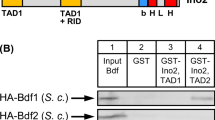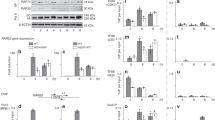Abstract
BTF3, initially discovered as a factor required for transcription inititation of RNA polymerase II, is expressed in two isoforms, termed a and b. BTF3b, the transcriptionally inactive isoform, was identified as an interaction partner of protein kinase CK2 subunit β employing the interaction trap system for screening of a HeLa cDNA fusion library. We report here on the interaction between the other isoform, BTF3a, and protein kinase CK2. The complete cDNA of BTF3a was cloned by RT-PCR and used for analysis in the two-hybrid system with a three-reporter yeast strain. Interaction of BTF3a with CK2 subunits α, α′ or β was detectable by one of three reporters, whereas the CK2β- BTF3a interaction was activating two reporters. It was also shown that BTF3a is phosphorylatedin vitro by the α2β2 holoenzyme, but not by α or α′ alone, indicating the requirement of β for substrate recognition. Immunoprecipitations of GST-fused BTF3a carried out in vitro resulted in co-precipitation of β. Similarly, GST-BTF3a, but not GST alone isolated with glutathione agarose beads from buffer containing recombinant CK2 subunits was found complexed with α and β, likely representing α2β2 holoenzyme. The data show a weak, nevertheless specific interaction of protein kinase CK2 via subunit β with the putative transcription factor BTF3a in vitro and in vivo, and a role of BTF3a as a potential new substrate for CK2.
Similar content being viewed by others
References
Pyerin W, Ackermann K, Lorenz P: Casein kinases. In: F. Marks (ed) Protein Phosphorylation. VCH, Weinheim, 1996, pp 117–147
Padmanabha R, Chen-Wu JL, Hanna DE, Glover CV: Isolation, sequencing, and disruption of the yeast CKA2 gene: Casein kinase II is essential for viability in Saccharomyces cerevisiae. Mol Cell Biol 10: 4089–4099, 1990
Krek W, Maridor G, Nigg EA: Casein kinase II is a predominantly nuclear enzyme. J Cell Biol 116: 43–55, 1992
Lorenz P, Pepperkok R, Ansorge W, Pyerin W: Cell biological studies with monoclonal and polyclonal antibodies against human casein kinase II subunit beta demonstrate participation of the kinase in mitogenic signaling. J Biol Chem 268: 2733–2739, 1993
Allende JE, Allende CC: Protein kinase CK2: An enzyme with multiple substrates and a puzzling regulation. FASEB J 9: 313–323, 1995
Zheng XM, Moncollin V, Egly JM, Chambon P: A general transcription factor forms a stable complex with RNA polymerase B (II). Cell 50: 361–368, 1987
Kanno M, Chalut C, Egly JM: Genomic structure of the putative BTF3 transcription factor. Gene 15: 219–228, 1992
Parthun MR, Mangus DA, Jaehning JA: The EGD I product, a yeast homolog of human BTF3, may be involved in GAL4 DNA binding. Mol Cell Biol 12: 5683–5689, 1992
Grein S, Raymond K, Cochet C, Pyerin W, Chambaz EM, Filhol O: Two-hybrid screening to search interaction partners of protein kinase CK2β subunit. Mol Cell Biochem (this issue)
James P, Halladay J, Craig EA: Genomic libraries and a host strain designed for highly efficient two-hybrid selection in yeast. Genetics 144: 1425–1436, 1996
Bodenbach L, Fauss J, Robitzki A, Krehan A, Lorenz P, Lozeman FJ, Pyerin W: Recombinant human casein kinase II. A study with the complete set of subunits (alpha, alpha ′ and beta), sitedirected autophosphorylation mutants and a bicistronically expressed holoenzyme. Eur J Biochem 220: 263–273, 1994
Bradford MM: A rapid and sensitive method for the quantitation of microgram quantities of protein utilizing the principle of protein-dye binding. Anal Biochem 72: 248–254, 1976
Ito H, Fukuda Y, Murata K, Kimura A: Transformation of intact yeast cells treated with alkali cations. J Bacteriol 153: 163–168, 1983
Emini EA, Hughes JV, Perlow DS, Boger J: Induction of hepatitis A virus-neutralizing antibody by a virus-specific synthetic peptide. J Virol 55: 836–839, 1985
Jameson BA, Wolf H: The antigenic index: a novel algorithm for predicting antigenic determinants. Comput Appl Biosci 4: 181–186, 1988
Krehan A, Lorenz P, Plana-Coll M, Pyerin W: Interaction sites between catalytic and regulatory subunits in human protein kinase CK2 holoenzymes as indicated by chemical cross-linking and immunological investigations. Biochemistry 35: 4966–4975, 1996
Laemmli UK: Cleavage of structural proteins during the assembly of the head of bacteriophage T4. Nature 227: 680–685, 1970
Kyhse-Andersen J: Electroblotting of multiple gels: A simple apparatus without buffer tank for rapid transfer of proteins from polyacrylamide to nitrocellulose. J Biochem Biophys Methods 10: 203–209, 1984
Pyerin W, Taniguchi H, Horn F, Oesch F, Amelizad Z, Friedberg T, Wolf CR: Isoenzyme-specific phosphorylation of cytochromes P-450 and other drug metabolizing enzymes. Biochem Biophys Res Commun 142: 885–892, 1987
Gyuris J, Golemis E, Chertkov H, Brent R: Cdi1, a human G1 and S phase protein phosphatase that associates with Cdk2. Cell 75: 791–803, 1993
Fields S, Song O: A novel genetic system to detect protein-protein interactions. Nature 340: 245–246, 1989
Harper JW, Adami GR, Wei N, Keyomarsi K, Elledge SJ: The p2l Cdk-interacting protein Cip1 is a potent inhibitor of G1 cyclin-dependent kinases. Cell 75: 805–816, 1993
Cochet C, Chambaz EM: Oligomeric structure and catalytic activity of G type casein kinase. Isolation of the two subunits and renaturation experiments. J Biol Chem 258: 1403–1406, 1983
Tuazon PT, Traugh JA: Casein kinase I and II multipotential serine protein kinases: Structure, function, and regulation. Adv Second Messenger Phosphoprotein Res 23: 123–164, 1991
Edelman AM, Blumenthal DK, Krebs EG: Protein serine/threonine kinases. Annu Rev Biochem 56: 567–613, 1987
Pinna LA: Casein kinase 2: An ‘eminence grise’ in cellular regulation? Biochim Biophys Acta 1054: 267–284, 1990
Meggio F, Marin O, Pinna LA: Substrate specificity of protein kinase CK2. Cell Mol Biol Res 40: 401–409, 1994
Marin O, Meggio F, Marchiori F, Borin G, Pinna LA: Site specificity of casein kinase-2 (TS) from rat liver cytosol. A study with model peptide substrates. Eur J Biochem 160: 239–244, 1986
Janin J, Wodak S: Conformation of amino acid side-chains in proteins. J Mol Biol 125: 357–386, 1978
Author information
Authors and Affiliations
Rights and permissions
About this article
Cite this article
Grein, S., Pyerin, W. BTF3 is a potential new substrate of protein kinase CK2. Mol Cell Biochem 191, 121–128 (1999). https://doi.org/10.1023/A:1006806226764
Issue Date:
DOI: https://doi.org/10.1023/A:1006806226764




